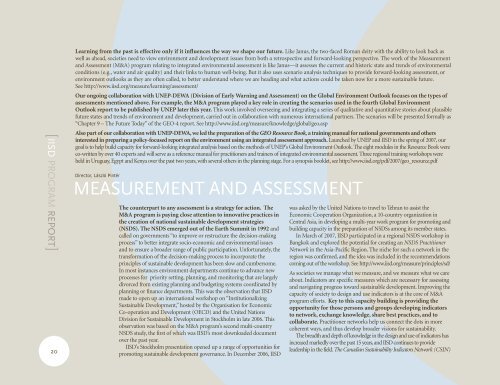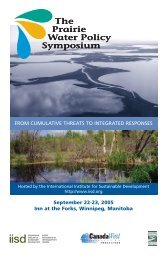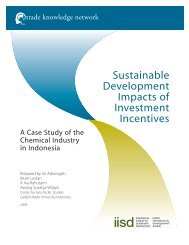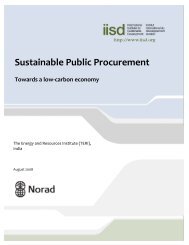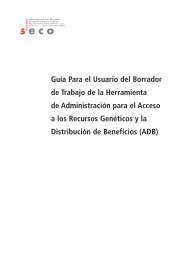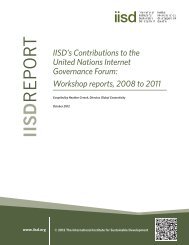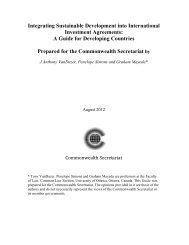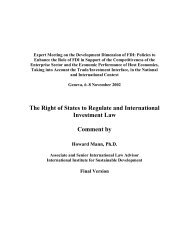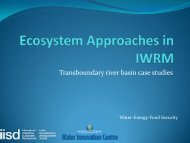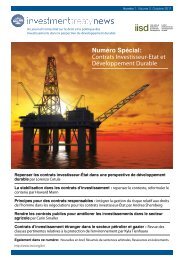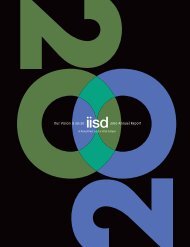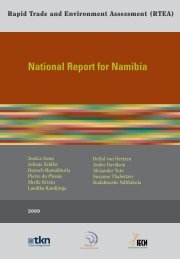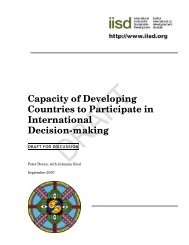2006/2007 Annual Report - International Institute for Sustainable ...
2006/2007 Annual Report - International Institute for Sustainable ...
2006/2007 Annual Report - International Institute for Sustainable ...
You also want an ePaper? Increase the reach of your titles
YUMPU automatically turns print PDFs into web optimized ePapers that Google loves.
[IISD PROGRAM REPORT]<br />
20<br />
Learning from the past is effective only if it influences the way we shape our future. Like Janus, the two-faced Roman deity with the ability to look back as<br />
well as ahead, societies need to view environment and development issues from both a retrospective and <strong>for</strong>ward-looking perspective. The work of the Measurement<br />
and Assessment (M&A) program relating to integrated environmental assessment is like Janus—it assesses the current and historic state and trends of environmental<br />
conditions (e.g., water and air quality) and their links to human well-being. But it also uses scenario analysis techniques to provide <strong>for</strong>ward-looking assessment, or<br />
environment outlooks as they are often called, to better understand where we are heading and what actions could be taken now <strong>for</strong> a more sustainable future.<br />
See http://www.iisd.org/measure/learning/assessment/<br />
Our ongoing collaboration with UNEP-DEWA (Division of Early Warning and Assessment) on the Global Environment Outlook focuses on the types of<br />
assessments mentioned above. For example, the M&A program played a key role in creating the scenarios used in the fourth Global Environment<br />
Outlook report to be published by UNEP later this year. This work involved overseeing and integrating a series of qualitative and quantitative stories about plausible<br />
future states and trends of environment and development, carried out in collaboration with numerous international partners. The scenarios will be presented <strong>for</strong>mally as<br />
“Chapter 9 – The Future Today” of the GEO-4 report. See http://www.iisd.org/measure/knowledge/global/geo.asp<br />
Also part of our collaboration with UNEP-DEWA, we led the preparation of the GEO Resource Book, a training manual <strong>for</strong> national governments and others<br />
interested in preparing a policy-focused report on the environment using an integrated assessment approach. Launched by UNEP and IISD in the spring of <strong>2007</strong>, our<br />
goal is to help build capacity <strong>for</strong> <strong>for</strong>ward-looking integrated analysis based on the methods of UNEP’s Global Environment Outlook. The eight modules in the Resource Book were<br />
co-written by over 40 experts and will serve as a reference manual <strong>for</strong> practitioners and trainers of integrated environmental assessment. Three regional training workshops were<br />
held in Uruguay, Egypt and Kenya over the past two years, with several others in the planning stage. For a synopsis booklet, see http://www.iisd.org/pdf/<strong>2007</strong>/geo_resource.pdf<br />
Director, László Pintér<br />
MEASUREMENT AND ASSESSMENT<br />
The counterpart to any assessment is a strategy <strong>for</strong> action. The<br />
M&A program is paying close attention to innovative practices in<br />
the creation of national sustainable development strategies<br />
(NSDS). The NSDS emerged out of the Earth Summit in 1992 and<br />
called on governments “to improve or restructure the decision-making<br />
process” to better integrate socio-economic and environmental issues<br />
and to ensure a broader range of public participation. Un<strong>for</strong>tunately, the<br />
trans<strong>for</strong>mation of the decision-making process to incorporate the<br />
principles of sustainable development has been slow and cumbersome.<br />
In most instances environment departments continue to advance new<br />
processes <strong>for</strong> priority setting, planning, and monitoring that are largely<br />
divorced from existing planning and budgeting systems coordinated by<br />
planning or finance departments. This was the observation that IISD<br />
made to open up an international workshop on “Institutionalizing<br />
<strong>Sustainable</strong> Development,” hosted by the Organisation <strong>for</strong> Economic<br />
Co-operation and Development (OECD) and the United Nations<br />
Division <strong>for</strong> <strong>Sustainable</strong> Development in Stockholm in late <strong>2006</strong>. This<br />
observation was based on the M&A program’s second multi-country<br />
NSDS study, the first of which was IISD’s most downloaded document<br />
over the past year.<br />
IISD’s Stockholm presentation opened up a range of opportunities <strong>for</strong><br />
promoting sustainable development governance. In December <strong>2006</strong>, IISD<br />
was asked by the United Nations to travel to Tehran to assist the<br />
Economic Cooperation Organization, a 10-country organization in<br />
Central Asia, in developing a multi-year work program <strong>for</strong> promoting and<br />
building capacity in the preparation of NSDSs among its member states.<br />
In March of <strong>2007</strong>, IISD participated in a regional NSDS workshop in<br />
Bangkok and explored the potential <strong>for</strong> creating an NSDS Practitioner<br />
Network in the Asia-Pacific Region. The niche <strong>for</strong> such a network in the<br />
region was confirmed, and the idea was included in the recommendations<br />
coming out of the workshop. See http://www.iisd.org/measure/principles/sd/<br />
As societies we manage what we measure, and we measure what we care<br />
about. Indicators are specific measures which are necessary <strong>for</strong> assessing<br />
and navigating progress toward sustainable development. Improving the<br />
capacity of society to design and use indicators is at the core of M&A<br />
program ef<strong>for</strong>ts. Key to this capacity building is providing the<br />
opportunity <strong>for</strong> those persons and groups developing indicators<br />
to network, exchange knowledge, share best practices, and to<br />
collaborate. Practitioner networks help us connect the dots in more<br />
coherent ways, and thus develop broader visions <strong>for</strong> sustainability.<br />
The breadth and depth of knowledge in the design and use of indicators has<br />
increased markedly over the past 15 years, and IISD continues to provide<br />
leadership in the field. The Canadian Sustainability Indicators Network (CSIN)


